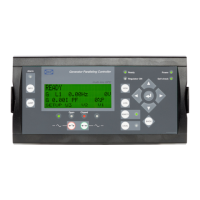7. Synchronisation
7.1 General information
Two different synchronisation principles are available, namely static and dynamic synchronisation (dynamic is
selected by default). This chapter describes the principles of the synchronisation functions and the adjust-
ment.
In the following, the term “synchronisation” means “synchronising and closing of the
synchronised breaker”.
7.2 Dynamic synchronisation
In dynamic synchronisation, the synchronising genset is running at a different speed than the generator on
the busbar. This speed difference is called slip frequency. Typically, the synchronising genset is running with
a positive slip frequency. This means that it is running with a higher speed than the generator on the busbar.
The objective is to avoid a reverse power trip after the synchronisation.
The dynamic principle is illustrated below.
In the example above, the synchronising genset is running at 1503 RPM ~ 50.1 Hz. The generator on load is
running at 1500 RPM ~ 50.0 Hz. This gives the synchronising genset a positive slip frequency of 0.1 Hz.
GPC-3 DRH 4189340587 UK
Synchronisation
DEIF A/S Page 111 of 122

